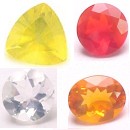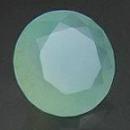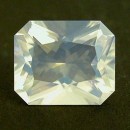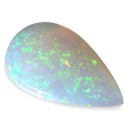|
Click on a letter above to view the list of gems. |
|
|
|
|
|
|
|
|
Opal |
|
Brazil & Mexico Fire, Contra Luz, Jelly and Precious Opals |
|
Peru Blue, Pink |
|
USA Idaho, Oregon, Nevada |
|
Others Africa, Australia, Ethiopia, Madagascar, Siberia, Tanzania |
||||
|
|
||||||||||
| Chemistry: SiO2 + 5-10% nH2O [Hydrated Silicon Dioxide] | |
| Prehistoric
Discovery;
IMA
status: Valid (pre-IMA; Grandfathered). | ||
|
| ||
|
Classification |
|
|
| |
|
Oxides | |
|
|
4 : Oxides & Hydroxides |
|
|
|
|
Crystal Data |
|
|
|
|
|
Amorphous (no crystalline forms) |
|
|
Amorphous - (no crystalline forms) Habits include Massive; Concretions; Botryoidal; Stalactitic; Reniform - "kidney like" in shape (e.g. Hematite); cavity fillings (e.g. in fractures and geodes); replacement of other minerals or wood. |
|
|
|
|
|
Physical Properties |
|
|
|
|
|
None (amorphous) |
|
|
Conchoidal |
|
|
Brittle |
|
|
5.5 - 6.0 |
|
|
1.90 - 2.30 (g/cm3) |
|
|
Not Radioactive |
|
|
|
|
|
Optical Properties |
|
|
|
|
|
Colorless, white, yellow, orange, red, yellowish brown, greenish, blue, gray, black, violet. |
|
|
Transparent to Translucent to Opaque |
|
|
Vitreous, Waxy, Pearly, Dull |
|
|
1.43 Isotropic |
|
|
0.00 (Isotropic) |
|
|
Weak |
|
|
Distinct; red, orange, yellow, green, blue |
|
|
|
|
|
Occurances |
|
|
|
|
|
Geological Setting: |
Sedimentary and secondary from the alteration of high silica igneous extrusive rocks. |
|
Type Locality: |
n/a |
|
Year Discovered: |
Prehistoric discovery |
|
View mineral photos: | |
|
|
|
|
More Information |
|
|
|
|
|
| |
|
|
|
|
Opal comes in a wide variety of types and colors from many locations world wide. Opal has almost as many names as locations. Some Opal names are in reference to their locality such as Lightning Ridge, Coober Pedy and Virgin Valley. Other names are due to their color or type such as Cherry, Common, Girasol, Hyalite, Water, Fire, Jelly, Milk, Black, Crystal, Hydrophane, Moss and Harlequin. Many Opals are transparent but others are only known to be opaque and are made into beautiful cabochons with amazing color play like Australian Opals. Australian Opal cabochons can have translucent to opaque white, gray or black body colors with beautiful color play on their surface. Transparent opals may have solid body colors with no color play or they may be lightly colored or colorless but show beautiful internal color play with all the colors of a rainbow. These may be called Contra Luz or Precious Opal because of their amazing internal color play when lighted from behind. Some Opals from Ethiopia have both strong body colors and beautiful internal color play. Faceted Brazilian and Mexican Opals are usually found in vivid colors of yellow, orange and red. They are often called Fire Opals for their body colors resembling the colors of fire, not due to internal fire or color play. Colorless Opals are often called Jelly, Water, Crystal, Girasol or Hyalite Opal. Hyalite Opal from Madagascar is colorless with a soft, beautiful glow. There are also opaque Opals with no color play just beautiful pastel colors like pink Opal from Peru; blue Opal from Owyhee, Oregon; and pale green Opal from Siberia and Africa. The USA has several locations known for beautiful Opals including Idaho, Oregon and Nevada. Although Opal is amorphous (no crystal structure) it does have a structure of sorts. Opal is composed of tiny spherical particles as a solidified gel also containing 5-10% water. Random chains of silicon dioxide and water are arranged into tiny spheres. In most Opals these spheres are irregular in size and concentration, kind of jumbled. But in Opals with color play, such as Contra-luz or Precious Opal, there are many pockets of spheres that are of approximately equal size and have a regular concentration, or structure. The water contained in these pockets of somewhat organized structure has the effect of diffracting light at various wavelengths creating a display of different colors. This effect is similar to when a rainbow is created from the sun shining through water particles in the air. Each pocket may produce a different color or different intensity of color depending on their angle in the composition and the angle at which the gem is viewed. This effect creates the beautiful color play or opalescence that makes some Opals much more valuable than others. Since Opal contains water, it may also dehydrate causing it to craze, crack or become very cloudy or even opaque. This may happen as soon as it is removed from the ground or years later. When this happens, a beautiful Opal may become ugly and worthless. Of
all the Opal taken out of the ground, 95% is valueless
"potch" and 95% of the remainder is low quality.
Only a mere 0.25% ever makes it to market as a gem. |
|



